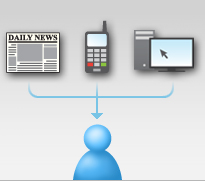
In marketing there is a big focus on connecting with the right audience and moving prospects closer to purchasing products. In fact, many organizations evaluate the effectiveness of a campaign (or even a complete marketing team) based on the leads that that it generates. We are not going to discuss in this blog if this is the right metric, or not, because in most cases, marketing has no choice but to live up to these expectations. So when leads are what counts and you are planning to use the web as a targeting tool, remember that the value of your offer is what will impact the success of your program the most.
I think we could all guess that high-value, unique materials created exclusively for a particular online marketing program will perform well, but what is a marketer to do that has a limited budget or limited amount of time until program launch? Most of the time, creating a valuable offer takes research, access to product managers, an experienced writer, and lots and lots of time for review. For those who are missing the luxury of time and budget, there is a faster, simpler, and equally effective route. Rather than creating a fresh piece of collateral, for many, the answer is in aggregation content. Pulling together a variety of existing pieces around a common theme can create a high value offer that is unique to your target audience and can provide you with an asset that is sure to perform. Even if all of these materials were previously published, the new value that you’ve added is in collecting and then connecting these pieces so that people can now view them as a whole. It might be easier to think about this idea as if you’ve pulled a series of chapters together into a single book to tell a focused story – rather than leaving it to the reader to go discover these individual pieces on their own. The value is derived from the connections and research that you’ve done to connect these materials.
There are three specific rules to remember when building an aggregated piece.
1) Consider the Buying Cycle: When you are collecting materials, you should consider the steps in the buying process that your prospects are likely to follow. In general the buy cycle has 4 core steps of:
- General Education – readers seek credible information that will provide a technical or market overview
- Business Case Development – when prospects seek information on a specific product or group of products’ functionality and capability
- Vendor Shortlist and Evaluations – focused on cost. ROI, and service performance
- Final Selection – where pricing and term and conditions are most important
2) Provide a variety of content ranging from general market information and trends, to case studies, core feature sets, to specific product, service and company information to help form their ultimate buying criteria. A package that brings all of this together in a simple and easy to print guide and effectively promoted to the right audience will surely drive response.
3) Remember, content can be a in a variety of forms and formats. It is not important that all of this information be in a text form. Audio and video clips can easily be added into the mix to help provide readers with a more complete understanding of a core issue. If you are providing a downloadable document, then consider offering links to materials on the web. This strategy will keep your material light enough to be easily shared.
So if you are under the gun to provide marketing leads, consider aggregating high value material that was previously dispersed over your website or over the web. The value will invite readers to learn more and you will be rewarded with a high performing program that is faster and less expensive to bring to market.

-Dan Hirsh, Partner, MediaSolve